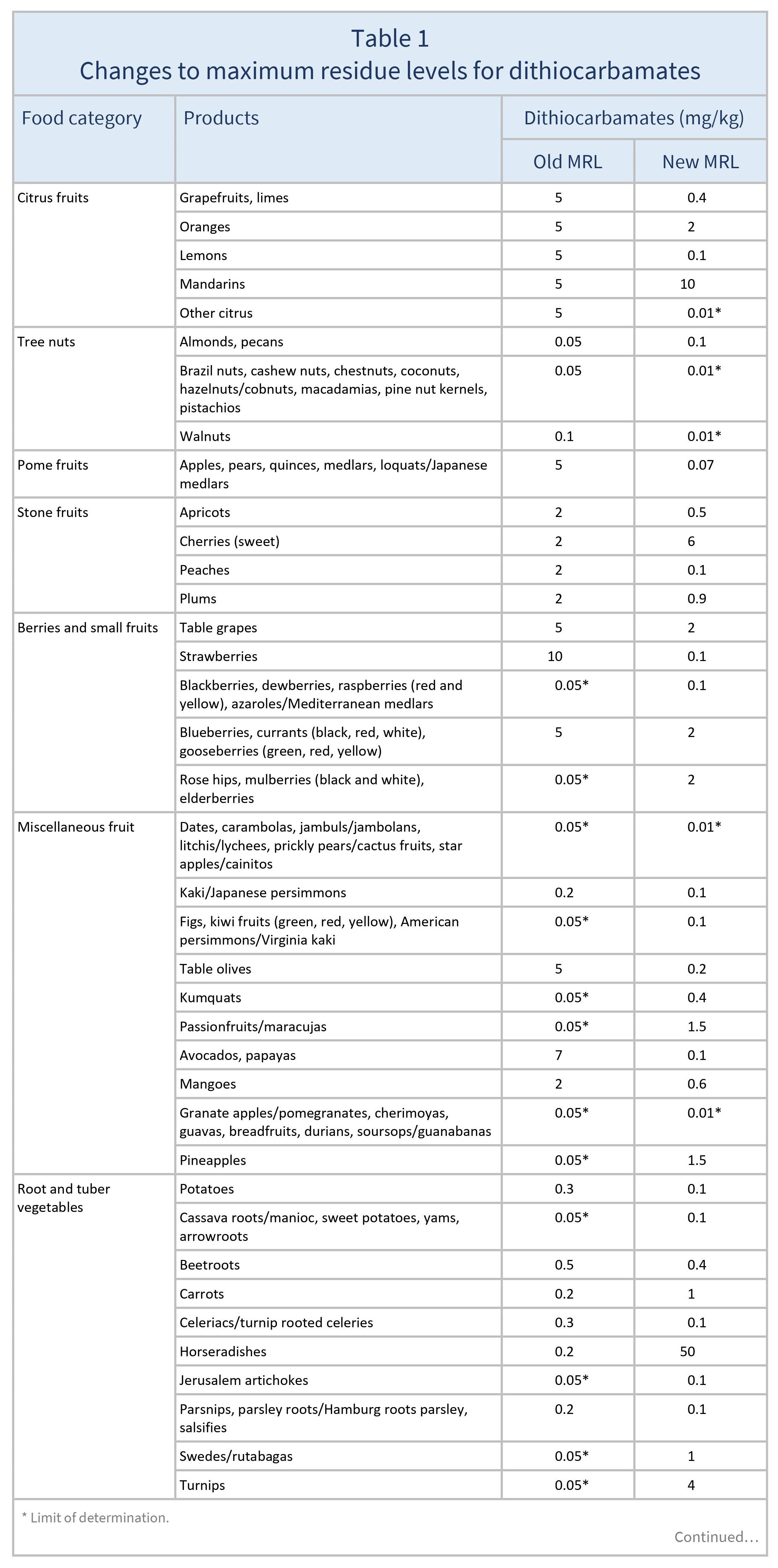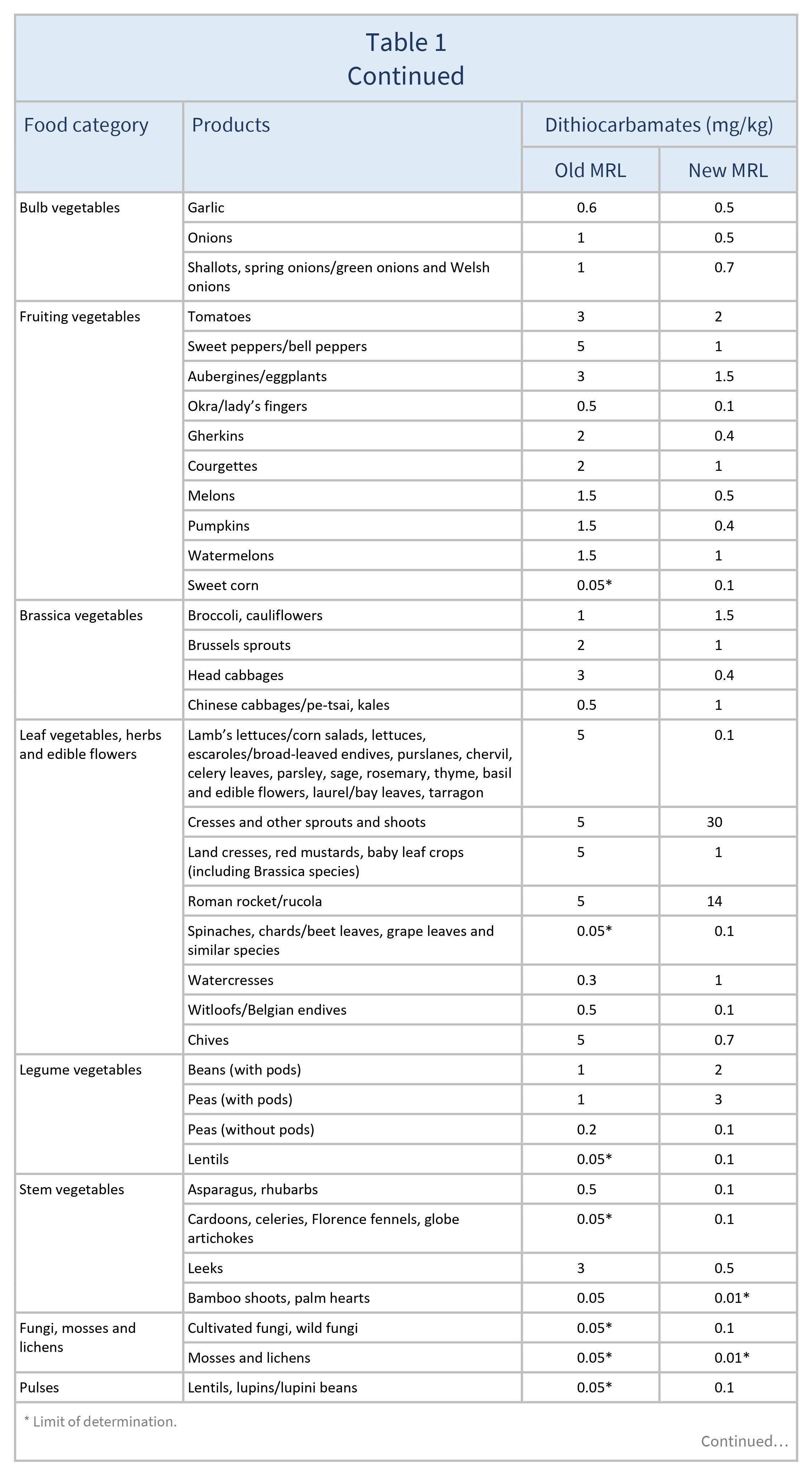Maximum residue levels for dithiocarbamates
- Food safety
- Pesticide MRLs
Summary
The European Commission has informed the World Trade Organization Sanitary and Phytosanitary Measures (WTO SPS) Committee that it intends to amend the maximum residue levels (MRLs) for dithiocarbamates (G/SPS/N/EU/788). Revised MRLs are proposed for a wide range of products, and may particularly impact exporters of apples, pears, quinces, medlars, and loquats (reduction of MRL from 5 to 0.07 mg/kg), and oil palms kernels/fruits (reduction of MRL to the limit of determination, LOD). The LOD is the lowest level that can be detected using the most modern and reliable analytical methods.
The MRLs are set for the group of dithiocarbamates that includes maneb, mancozeb, metiram, propineb, thiram, and ziram.
EU proposes to amend MRLs for dithiocarbamates
Draft Commission Regulation amending Annexes II and III to Regulation (EC) No 396/2005 of the European Parliament and of the Council as regards maximum residue levels for dithiocarbamates in or on certain products
Draft Annex
Update
The European Commission has informed the World Trade Organization Sanitary and Phytosanitary Measures (WTO SPS) Committee that it intends to amend the maximum residue levels (MRLs) for dithiocarbamates (G/SPS/N/EU/788). Revised MRLs are proposed for a wide range of products, and may particularly impact exporters of apples, pears, quinces, medlars, and loquats (reduction of MRL from 5 to 0.07 mg/kg), and oil palms kernels/fruits (reduction of MRL to the limit of determination, LOD). The LOD is the lowest level that can be detected using the most modern and reliable analytical methods.
The MRLs are set for the group of dithiocarbamates that includes maneb, mancozeb, metiram, propineb, thiram, and ziram.
Impacted Products
Grapefruits, limes, oranges, lemons, mandarins, other citrus, almonds, pecans, Brazil nuts, cashews, chestnuts, coconuts, hazelnuts/cobnuts, macadamias, pine nut kernels, pistachios, walnuts, apples, pears, quinces, medlars, loquats/Japanese medlars, apricots, cherries (sweet), peaches, plums, table grapes, strawberries, blackberries, dewberries, raspberries, azaroles/Mediterranean medlars, blueberries, currants, gooseberries, rose hips, mulberries, elderberries, dates, kumquats, carambolas, jambuls/jambolans, lychees, prickly pears/cactus fruits, star apples/cainitos, figs, kiwi fruits, kaki/Japanese persimmons, American persimmons/Virginia kaki, table olives, passionfruits/maracujas, avocados, papayas, mangoes, granate apples/pomegranates, cherimoyas, guavas, breadfruits, durians, soursops/guanabanas, pineapples, potatoes, cassava roots/manioc, sweet potatoes, yams, arrowroots, beetroots, carrots, celeriacs/ turnip rooted celeries, horseradishes, Jerusalem artichokes, parsnips, parsley roots/Hamburg roots parsley, salsifies, swedes/rutabagas, turnips, garlic, onions, shallots, spring onions/ green onions and Welsh onions, tomatoes, sweet peppers/bell peppers, aubergines/eggplants, okra/ lady’s fingers, gherkins, courgettes, melons, pumpkins, watermelons, sweet corn, broccoli, cauliflowers, Brussels sprouts, head cabbages, Chinese cabbages/ pe-tsai, kales, lamb’s lettuces/corn salads, lettuces, escaroles/broad-leaved endives, purslanes, chervil, celery leaves, parsley, sage, rosemary, thyme, basil and edible flowers, laurel/bay leaves, tarragon, cresses and other sprouts and shoots, land cresses, red mustards, baby leaf crops (including Brassica species), Roman rocket/rucola, spinaches, chards/beet leaves, grape leaves and similar species, watercresses, witloofs/Belgian endives, chives, beans (with pods), peas (with pods), peas (without pods), lentils, asparagus, rhubarbs, cardoons, celeries, Florence fennels, globe artichokes, leeks, bamboo shoots, palm hearts, cultivated fungi, wild fungi, mosses and lichens, lentils, lupins/lupini beans, [seeds of: poppy, sesame, sunflower, pumpkin, safflower, borage, gold of pleasure, hemp, rape/canola, mustard, cotton], castor beans, soyabeans, olives for oil production, oil palm kernels & fruits, barley, maize/corn, buckwheat, pseudocereals, millet, oats, rice, rye, sorghum, hops, kapok, teas, coffee beans, cocoa, carobs/St John’s breads, chamomile, hibiscus, rose, jasmine, lime/linden, strawberry, rooibos, valerian, maté, aniseed, black caraway, celery, coriander, dill, fennel, fenugreek, nutmeg, allspice/pimento, Sichuan pepper, caraway, cardamom, juniper berry, peppercorns, vanilla, tamarind, turmeric, cloves, saffron, mace, cumin, cinnamon, liquorice, capers, sugar beet roots, sugar canes, chicory roots, swine, cattle, sheep, goat, horse, and poultry muscle, fat, liver, kidney, edible offals (other than liver and kidney), milk (cattle, sheep, goat, horse), bird eggs (chicken, duck, geese, quail)
What is changing?
The EU proposes to amend the MRLs for dithiocarbamates as summarised in Table 1.
Why?
The European Union has conducted a comprehensive review of the MRLs for dithiocarbamates as part of its regular review of MRLs.
Several pesticides belong to the dithiocarbamates group, including maneb, mancozeb, metiram, propineb, thiram, and ziram. The analytical method used to quantify the presence of these substances is based on their conversion into carbon disulphide (CS2), so a single MRL is established for the group (although a specific MRL also exists for thiram, see Maximum residue levels for thiram).
The European Food Safety Authority (EFSA 2023) has reviewed the MRLs for dithiocarbamates. For products where Codex MRLs (CXLs) or import tolerances exist and are considered safe, the European Commission proposes to adjust the MRLs accordingly. CS2 can occur naturally in some plants. In some cases, EFSA used monitoring data from organic products to identify the natural CS2 content in certain plants, which is unrelated to (and should not be confused with) the use of pesticides.
The Commission proposes to set the MRLs at the specific LODs for products where the use of plant protection products containing the active substances for dithiocarbamates is not authorised, if no import tolerances or CXLs exist.
As limited data was available for certain products, further evaluations and potential adjustments are planned within 2 years.
Timeline
The new MRLs will apply from approximately August 2025 – the precise date will be known once the Regulation is published.
Products (except pome fruits, table grapes, mangoes, apricots, peaches, strawberries, currants, papayas, and potatoes) exported before August 2025 that comply with the old MRLs will not be removed from the EU market after August 2025, even if they do not comply with the new MRLs.
Recommended Actions
Suppliers of all products should review their current use of dithiocarbamates (maneb, mancozeb, metiram, propineb, thiram, and ziram) and residue levels. Suppliers of apples, pears, quinces, medlars and loquats, nuts, and oil palm kernels/fruits in particular should evaluate their current use of these substances and explore possible alternative solutions in anticipation of these MRL changes.
Authorities in countries that are members of the WTO can provide feedback on the EU’s proposal (G/SPS/N/EU/788) by emailing the EU SPS Enquiry Point until 20 September 2024.
Background
MRLs are set in accordance with the rules set out in Regulation 396/2005. For information on current MRLs for other substances, please consult the EU Pesticide Residues database.
Resources
EFSA (2023) Review of the existing maximum residue levels for dithiocarbamates according to Article 12 of Regulation (EC) No 396/2005. EFSA Journal, 21(5): 7987.
Sources
Draft Commission Regulation as regards maximum residue levels for dithiocarbamates in or on certain products
Draft Annex
Tables & Figures
Disclaimer: Under no circumstances shall COLEAD be liable for any loss, damage, liability or expense incurred or suffered that is claimed to have resulted from the use of information available on this website or any link to external sites. The use of the website is at the user’s sole risk and responsibility. This information platform was created and maintained with the financial support of the European Union. Its contents do not, however, reflect the views of the European Union.
EU proposes to amend MRLs for dithiocarbamates
Draft Commission Regulation as regards maximum residue levels for dithiocarbamates in or on certain products
Draft Annex
What is changing and why?
Following a comprehensive review of the maximum residue levels (MRLs) for dithiocarbamates, the EU is proposing to amend the MRLs on many foods. The dithiocarbamates group includes the pesticides maneb, mancozeb, metiram, propineb, thiram, and ziram.
For products where the use of dithiocarbamates is not authorised in the EU, if no import tolerances or Codex MRLs (CXLs) exist, the Commission proposes to reduce the MRLs to the limit of determination. This may have particular impacts on exports of nuts and oil palm kernels/fruit.
The changes are set out in Table 1.
Actions
Suppliers of all products should review their current use of dithiocarbamates (maneb, mancozeb, metiram, propineb, thiram, and ziram) and residue levels. Suppliers of apples, pears, quinces, medlars and loquats, nuts, and oil palm kernels/fruits in particular should evaluate their current use of these substances and explore possible alternative solutions in anticipation of these MRL changes.
Authorities in countries that are members of the World Trade Organization can provide feedback on the EU’s proposal (G/SPS/N/EU/788) by emailing the EU SPS Enquiry Point until 20 September 2024.
Timeline
The new MRLs will apply from approximately August 2025 – the precise date will be known once the Regulation is published.
Products (except pome fruits, table grapes, mangoes, apricots, peaches, strawberries, currants, papayas, and potatoes) exported before August 2025 that comply with the old MRLs will not be removed from the EU market after August 2025, even if they do not comply with the new MRLs.
Tables & Figures
Disclaimer: Under no circumstances shall COLEAD be liable for any loss, damage, liability or expense incurred or suffered that is claimed to have resulted from the use of information available on this website or any link to external sites. The use of the website is at the user’s sole risk and responsibility. This information platform was created and maintained with the financial support of the European Union. Its contents do not, however, reflect the views of the European Union.



